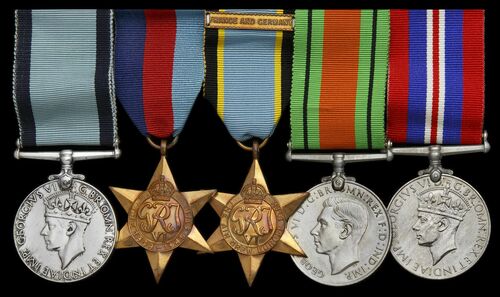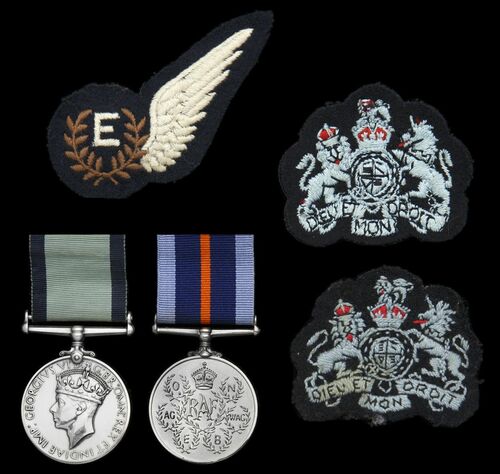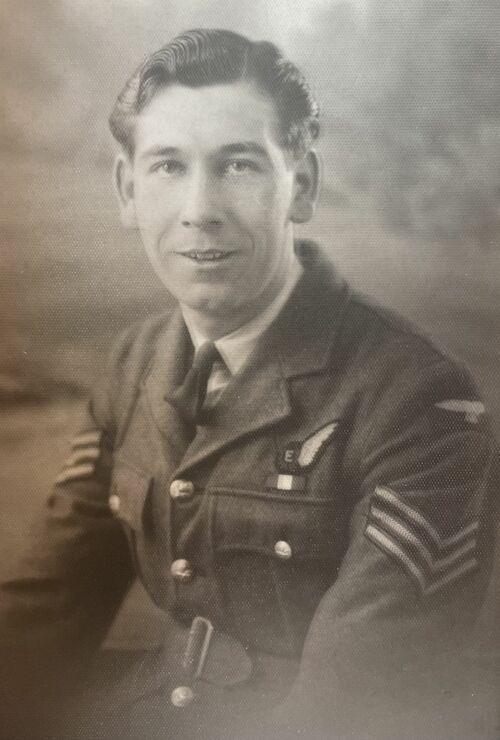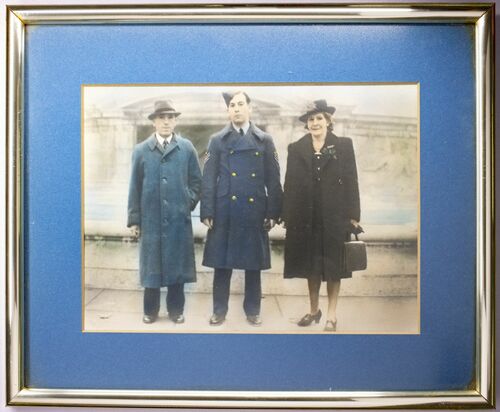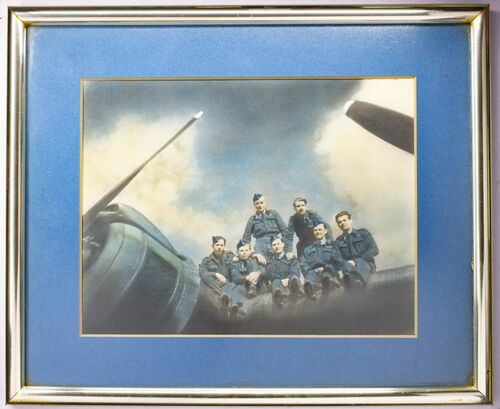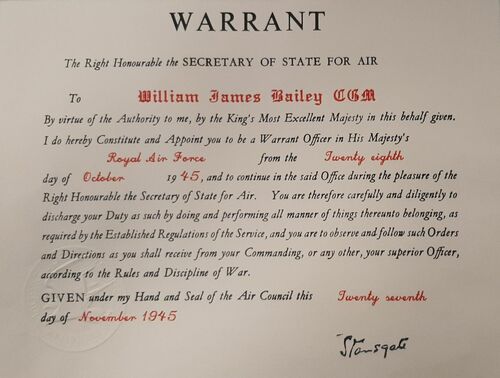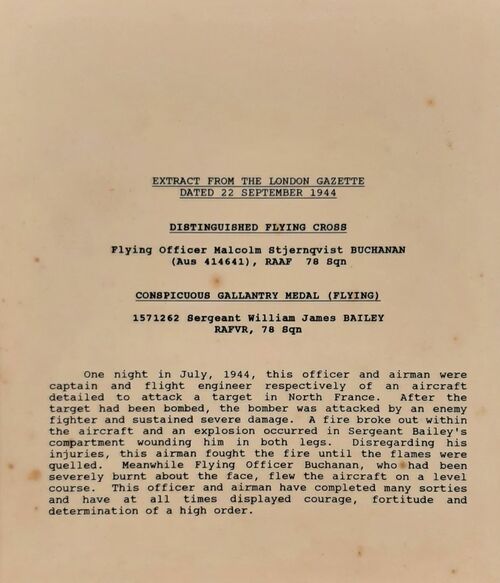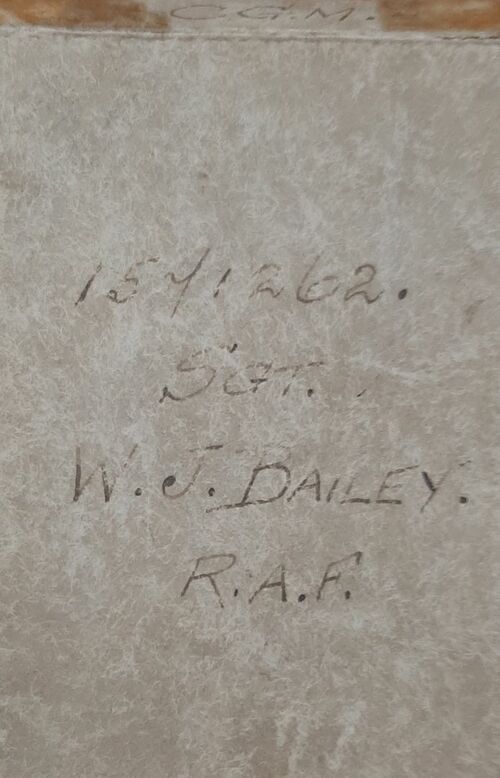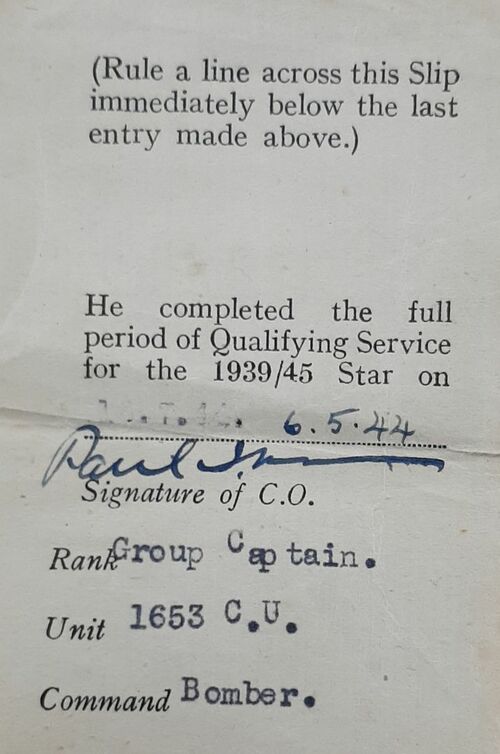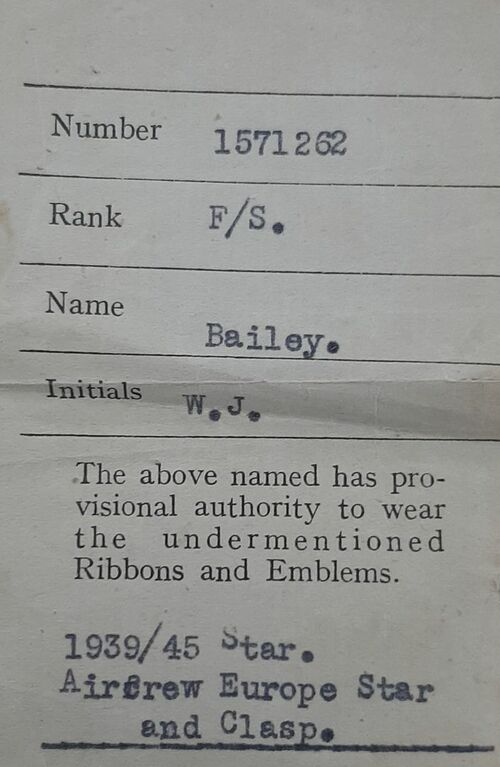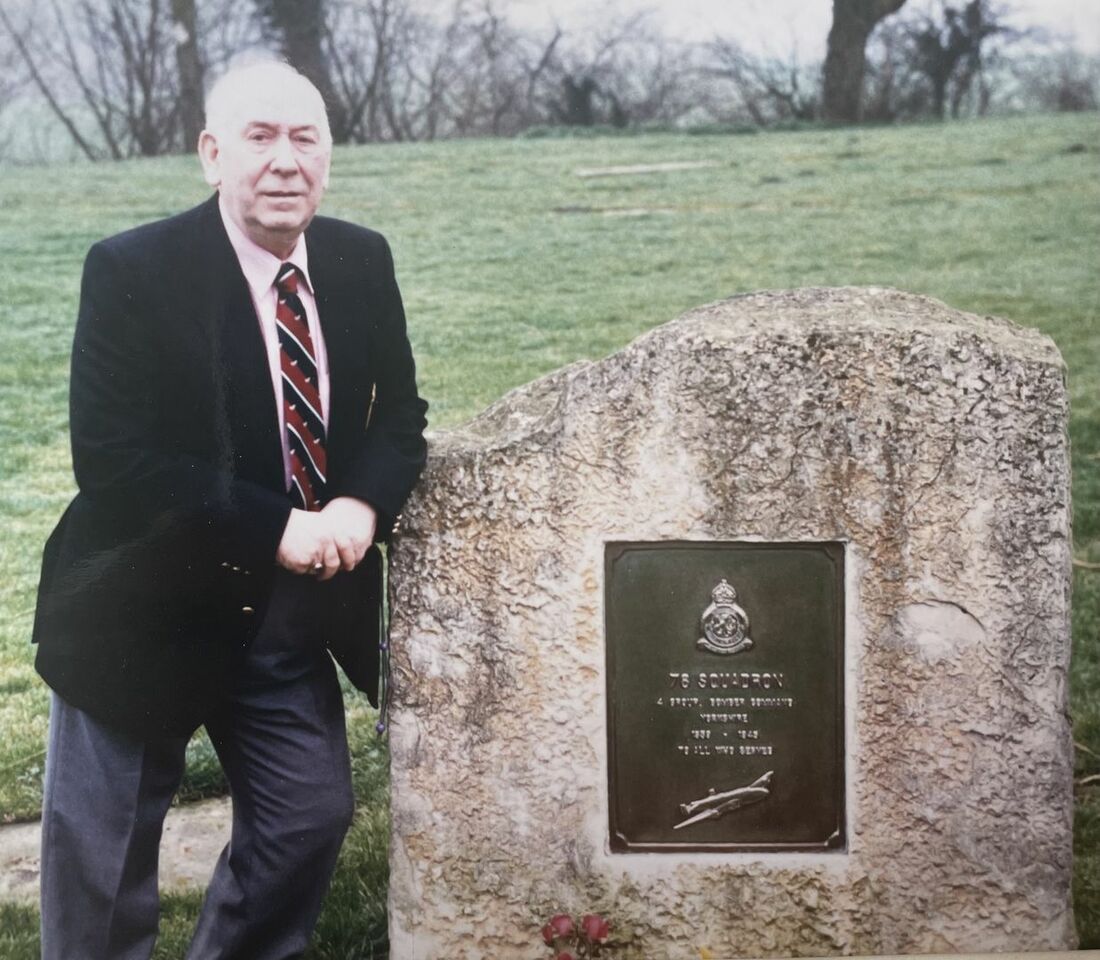Auction: 24001 - Orders, Decorations and Medals
Lot: 222
Sold by Order of a Direct Descendant
A fine Second World War Immediate C.G.M. group of five awarded to Flight Sergeant, later Warrant Officer W. J. Bailey, No. 78 Squadron, Royal Air Force Volunteer Reserve, who was decorated for his outstanding gallantry after his Halifax was shot up by an enemy fighter on the hair-raising return leg from bombing the V-1 rocket sites at Acquet; with his aircraft ablaze and having suffered severe wounds to his legs, Bailey was trapped in the aircraft but immediately went to the assistance of his comrades
Bailey thence took on firefighting duties and was further burned to the face and hands in rescuing the mid-upper Gunner, whilst the Captain nursed the aircraft home for a treacherous crash-landing at West Malling; duly rewarded with the C.G.M., Bailey was stranded on 29 Ops, in a strange twist of fate his wounds meant he was still recovering in hospital when his Skipper took to the skies to complete the Tour, he did not return
Conspicuous Gallantry Medal (Flying), G.VI.R. (1571262. Sgt. W. J. Bailey. R.A.F.), with its named card box of issue and on original investiture pin; 1939-45 Star; Air Crew Europe Star, clasp, France and Germany; Defence and War Medals 1939-45, the campaign medals in their card box of issue, named to 'W. J. Bailey, 46 Ryhope Street, Ryhope Colliery, Co. Durham.' and with Air Council forwarding slip and confirming notes, together with unofficial 'Bomber Command Medal', mounted as worn, good very fine (6)
C.G.M. London Gazette 22 September 1944; joint citation with Flying Officer M. S. Buchanan, D.F.C., R.A.A.F:
'One night in July, 1944, this officer and airman were Captain and Flight Engineer respectively of an aircraft detailed to attack a target in North France [Acquet]. After the target had been bombed, the bomber was attacked by an enemy fighter and sustained severe damage. A fire broke out within the aircraft and an explosion occurred in Sergeant Bailey's compartment wounding him in both legs. Disregarding his injuries, this airman fought the fire until the flames were quelled. Meanwhile Flying Officer Buchanan, who had been severely burnt about the face, flew the aircraft on a level course. This officer and airman have completed many sorties and have at all times displayed courage, fortitude and determination of a high order.'
The remarks by of the Station Commander:
'This N.C.O., although badly wounded, rose to the occasion and displayed those qualities of courage and disregard for personal safety which are in keeping with the finest traditions of the Service.
By his prompt action under great difficulties he not only saved the aircraft from destruction but also the lives of three members of his crew. I strongly recommend the award of the C.G.M. (Flying).'
The final remark of the Air Officer Commanding:
'I strongly recommend this gallant Flight Engineer for the immediate award of the C.G.M.'
William James Bailey was born in Sunderland on 17 November 1923 and was employed in the carpentry and joinery trade before joining the Royal Air Force Volunteer Reserve. Having attended a heavy conversion unit at R.A.F. Riccall in North Yorkshire, between November 1943 and February 1944, and qualified as a Flight Engineer, Bailey was posted to No. 78 Squadron, a Halifax unit, at nearby R.A.F. Breighton.
Whilst there, he crewed up with Flight Sergeant Malcolm Stjernqvist Buchanan's crew, the skipper being a member of the Royal Australian Air Force hailing from Goomboorian, Queensland. He commenced his Operational Tour in March 1944, when he flew two missions to France and two to Germany - Stuttgart on the 15th and Berlin on the 23rd; owing to a burst hydraulic pipe his aircraft had to land at Ford rather than Breighton on the 15th.
Nine further sorties were flown in May, mainly of the French variety as the Normandy landings approached, but also to Dusseldorf and Karlsruhe. And in June the French agenda continued apace, including an attack on enemy gun sites at Caen and three minelaying sorties to Brest; one of the latter outings ended with Bailey and his crew returning on three engines and a u/s rear turret. July also included a minelaying operation - to St. Nazaire - in addition to strikes against V-weapon sites, among them Thiverny.
He and his crew were now approaching the end of their operational tour, a trip to Caen in the first week of August being their 28th Op. Next up, on 18 July, was a sortie to Acquet. Alan Cooper's In Action With The Enemy takes up the story:
'Operation 29 for them was an attack on a V.1 site at Acquet, in France. They took off at 10.05 p.m. in Halifax MZ788 and successfully bomber the target from 12,000 feet with sixteen 500lb. bombs. On the return journey, while crossing the French coast, they were intercepted by a German night fighter and hit by cannon fire which caused an explosion in the flight engineer's compartment and started a fire. As the shell exploded, Bailey was hit in both legs.
With the Halifax ablaze, Buchanan gave the order to bale out and the navigator, Flying Officer Rayment, the bomb aimer, Flight Sergeant McKenzie and rear gunner Sergeant Hamer, all baled out over the sea. However, the wounded Bailey was unable to do so, not only because of his leg wounds but also because he could not get to his parachute owing to the fire. He called Buchanan, telling his position and that he was going to try and tackle the flames. He then grabbed the extinguisher and did indeed put out the fire although suffering burns to his face and hands. He then discovered that the mid-upper gunner, Sergeant McCannon, was trapped in his turret, so set to and got him out.
Buchanan was still making for England and on reaching the coast, the wireless operator, Sergeant Rice, called up the nearest base - West Malling, a fighter station in Kent - but they replied that the runway was too short for a Halifax. Yet by now they were left with few options - they were committed. In they came at West Malling but quickly realised the controller had been right. They were going to run out of runway. The end came and the bomber went through a field and over an embankment before stopping, but they were down and the Halifax did not catch fire.
Bailey was taken to the sick bay and from there to Preston Hall hospital near Maidstone. He underwent an operation to remove shrapnel from his legs and had his burns treated. The fire had also reached Buchanan, and the Australian had also to be treated for injuries to his face and hands. Two of those who baled out, Rayment and McKenzie, were never seen again.
On 1 August, Bailey was recommended for the C.G.M. by his C.O.'
In writing home to his parents, Buchanan spoke of his admiration for his gallant Flight Engineer, who '...all through, even after beginning to suffer considerably, performed all of his duties though often losing skin from his burnt hands in doing so … He will be in hospital for a month or two yet'; copied letter included, together with a local newspaper report.
On recovering from his wounds and burns in late 1944, Bailey briefly returned to No. 78 Squadron, but he saw no further action, instead seeing out the war at heavy conversion units at R.A.F. Langar, Nottinghamshire and North Luffenham in Rutland.
With an agonising stroke of bad luck, both Buchanan and Bailey remained stranded on 29 Ops, just one short of the full Tour which would earn them a rotation. With Bailey still recovering from his wounds, the gallant Buchanan took to the skies for his final Op in Halifax MZ810 on 21 November, a raid on Sterkrade. Having made the target and returned home, they found themselves in a large 'stack' whilst trying to land and had to do several loops. In this period the wind and atmospheric conditions changed and thus the landing strip in use was required to be altered. Given his experience it fell upon Buchanan to make the first attempt, which was to be a 'dummy run'. The Halifax flew as instructed at between 50-100ft above the runway, after crossing the far end of the airfield boundary the aircraft climbed to around 300ft and then began a turn to rejoin the airfield circuit. At 2325hrs, while making the turn, the aircraft lost height, the port wing tip clipped trees in an area of woodland called Brindleys Plantation near the village of Spaldington, around two miles south-east of Breighton airfield. It then cartwheeled, struck a small building in the wood and caught fire. All seven members of the crew was killed. Buchanan was just 31 and is buried in Harrogate Stonefall Cemetery.
Bailey was fortunate to live to tell the tale and was made a Warrant Officer on 28 October 1945. He died in September 2001; sold with the recipient's original R.A.F. Navigator's, Air Bomber's and Air Gunner's Flying Log Book (Form 1767), with entries covering the period November 1943 to October 1945, framed Warrant Officer appointment, citation of award, together with framed coloured image after his investiture and his crew, besides portrait photograph.
Subject to 20% VAT on Buyer’s Premium. For more information please view Terms and Conditions for Buyers.
Sold for
£17,000
Starting price
£14000

